Using AnnAGNPS to Simulate Runoff, Nutrient, and Sediment Loads in an Agricultural Catchment with an On-Farm Water Storage System
Abstract
:1. Introduction
2. Materials and Methods
2.1. Study Site
2.2. Model Description
2.3. Model Input
3. Results and Discussion
3.1. Spatial Variation
3.2. Temporal Variation
3.3. Impact of Additional Agricultural Management Operations
4. Summary and Conclusions
Author Contributions
Funding
Acknowledgments
Conflicts of Interest
References
- Gerland, P.; Raftery, A.E.; Ševčíková, H.; Li, N.; Gu, D.; Spoorenberg, T.; Alkema, L.; Fosdick, B.K.; Chunn, J.; Lalic, N. World population stabilization unlikely this century. Science 2014, 346, 234–237. [Google Scholar] [CrossRef] [Green Version]
- Tilman, D.; Cassman, K.G.; Matson, P.A.; Naylor, R.; Polasky, S. Agricultural sustainability and intensive production practices. Nature 2002, 418, 671–677. [Google Scholar] [CrossRef] [PubMed]
- Tilman, D.; Balzer, C.; Hill, J.; Befort, B.L. Global food demand and the sustainable intensification of agriculture. Proc. Natl. Acad. Sci. USA 2011, 108, 20260–20264. [Google Scholar] [CrossRef] [Green Version]
- Ladapo, H.; Aminu, F. Agriculture and eutrophication of freshwaters: A review of control measures. J. Res. For. Wildl. Environ. 2017, 9, 67–74. [Google Scholar]
- Withers, P.; Neal, C.; Jarvie, H.; Doody, D. Agriculture and eutrophication: Where do we go from here? Sustainability 2014, 6, 5853. [Google Scholar] [CrossRef] [Green Version]
- Rabotyagov, S.; Kling, C.; Gassman, P.; Rabalais, N.; Turner, R. The economics of dead zones: Causes, impacts, policy challenges, and a model of the Gulf of Mexico hypoxic zone. Rev. Environ. Econ. Policy 2014, 8, ret024. [Google Scholar] [CrossRef] [Green Version]
- Rabalais, N.N.; Turner, R.E.; Scavia, D. Beyond science into policy: Gulf of Mexico hypoxia and the Mississippi River nutrient policy development for the Mississippi River watershed reflects the accumulated scientific evidence that the increase in nitrogen loading is the primary factor in the worsening of hypoxia in the northern gulf of mexico. BioScience 2002, 52, 129–142. [Google Scholar]
- Carpenter, S.R.; Stanley, E.H.; Vander Zanden, M.J. State of the world’s freshwater ecosystems: Physical, chemical, and biological changes. Annu. Rev. Environ. Resour. 2011, 36, 75–99. [Google Scholar] [CrossRef] [Green Version]
- Osmond, D.L. USDA water quality projects and the National Institute of Food and Agriculture Conservation Effects Assessment Project watershed studies. J. Soil Water Conserv. 2010, 65, 142A–146A. [Google Scholar] [CrossRef] [Green Version]
- Tomer, M.; Sadler, E.; Lizotte, R.; Bryant, R.; Potter, T.; Moore, M.; Veith, T.; Baffaut, C.; Locke, M.; Walbridge, M. A decade of conservation effects assessment research by the USDA Agricultural Research Service: Progress overview and future outlook. J. Soil Water Conserv. 2014, 69, 365–373. [Google Scholar] [CrossRef] [Green Version]
- Tomer, M.; Locke, M. The challenge of documenting water quality benefits of conservation practices: A review of USDA-ARS’s Conservation Effects Assessment Project watershed studies. Water Sci. Technol. 2011, 64, 300–310. [Google Scholar] [CrossRef] [PubMed]
- Her, Y.; Chaubey, I.; Frankenberger, J.; Jeong, J. Implications of spatial and temporal variations in effects of conservation practices on water management strategies. Agric. Water Manag. 2017, 180, 252–266. [Google Scholar] [CrossRef]
- Meals, D.W. Detecting changes in water quality in the Laplatte River watershed following implementation of BMPs. Lake Reserv. Manag. 1987, 3, 185–194. [Google Scholar] [CrossRef]
- Arabi, M.; Frankenberger, J.R.; Engel, B.A.; Arnold, J.G. Representation of agricultural conservation practices with SWAT. Hydrol. Process. 2008, 22, 3042–3055. [Google Scholar] [CrossRef]
- Lizotte, R.E.; Yasarer, L.M.W.; Locke, M.A.; Bingner, R.L.; Knight, S.S. Lake nutrient responses to integrated conservation practices in an agricultural watershed. J. Environ. Qual. 2017, 46, 330–338. [Google Scholar] [CrossRef]
- Bracmort, K.S.; Arabi, M.; Frankenberger, J.; Engel, B.A.; Arnold, J.G. Modeling long-term water quality impact of structural BMPs. Trans. ASAE 2006, 49, 367–374. [Google Scholar] [CrossRef] [Green Version]
- Meals, D.W.; Dressing, S.A.; Davenport, T.E. Lag time in water quality response to best management practices: A review. J. Environ. Qual. 2010, 39, 85–96. [Google Scholar] [CrossRef]
- Lam, Q.; Schmalz, B.; Fohrer, N. The impact of agricultural best management practices on water quality in a North German lowland catchment. Environ. Monit. Assess. 2011, 183, 351–379. [Google Scholar] [CrossRef]
- Santhi, C.; Kannan, N.; White, M.; Di Luzio, M.; Arnold, J.; Wang, X.; Williams, J. An integrated modeling approach for estimating the water quality benefits of conservation practices at the river basin scale. J. Environ. Qual. 2014, 43, 177–198. [Google Scholar] [CrossRef] [Green Version]
- Zhang, X.; Zhang, M. Modeling effectiveness of agricultural BMPs to reduce sediment load and organophosphate pesticides in surface runoff. Sci. Total Environ. 2011, 409, 1949–1958. [Google Scholar] [CrossRef]
- Yuan, Y.; Bingner, R.; Rebich, R. Evaluation of AnnAGNPS on Mississippi Delta MSEA watersheds. Trans. ASAE 2001, 44, 1183–1190. [Google Scholar] [CrossRef]
- Parajuli, P.B.; Nelson, N.O.; Frees, L.D.; Mankin, K.R. Comparison of AnnAGNPS and SWAT model simulation results in USDA-CEAP agricultural watersheds in South-Central Kansas. Hydrol. Process. 2009, 23, 748–763. [Google Scholar] [CrossRef]
- Abdelwahab, O.M.M.; Bingner, R.L.; Milillo, F.; Gentile, F. Evaluation of alternative management practices with the AnnAGNPS model in the Carapelle watershed. Soil Sci. 2016, 181, 293–305. [Google Scholar] [CrossRef]
- Lizotte, R.; Locke, M.; Bingner, R.; Steinriede, R.W.; Smith, S. Effectiveness of integrated best management practices on mitigation of atrazine and metolachlor in an agricultural lake watershed. Bull. Environ. Contam. Toxicol. 2017, 98, 447–453. [Google Scholar] [CrossRef] [PubMed]
- Pérez-Gutiérrez, J.D.; Paz, J.O.; Tagert, M.L.M. Seasonal water quality changes in on-farm water storage systems in a south-central U.S. agricultural watershed. Agric. Water Manag. 2017, 187, 131–139. [Google Scholar] [CrossRef] [Green Version]
- Pérez-Gutiérrez, J.D.; Paz, J.O.; Tagert, M.L.; Karki, R. Seasonal variation of water quality in on-farm water storage systems: Case study of a mississippi delta agricultural watershed. In Proceedings of the 2015 ASABE Annual International Meeting, New Orleans, LA, USA, 26–29 July 2015; American Society of Agricultural and Biological Engineers: St. Joseph Charter Township, MI, USA, 2015; p. 7. [Google Scholar]
- Moore, M.T.; Pierce, J.R.; Farris, J.L. Water-quality analysis of an intensively used on-farm storage reservoir in the northeast Arkansas Delta. Arch. Environ. Contam. Toxicol. 2015, 69, 89–94. [Google Scholar] [CrossRef]
- Pérez-Gutiérrez, J.D.; Paz, J.O.; Tagert, M.L.M.; Sepehrifar, M. Impact of rainfall characteristics on the NO3—N concentration in a tailwater recovery ditch. Agric. Water Manag. 2020, 233, 106079. [Google Scholar] [CrossRef]
- Karki, R.; Tagert, M.L.M.; Paz, J.O. Evaluating the nutrient reduction and water supply benefits of an on-farm water storage (OFWS) system in east Mississippi. Agric. Ecosyst. Environ. 2018, 265, 476–487. [Google Scholar] [CrossRef]
- Geter, W.F.; Theurer, F.D. AnnAGNPS-RUSLE sheet and rill erosion. In Proceedings of the First Federal Interagency Hydrologic Modeling Conference, Las Vegas, NV, USA, 19–23 April 1998; pp. 10–16. [Google Scholar]
- Bingner, R.; Theurer, F. AnnAGNPS: Estimating sediment yield by particle size for sheet and rill erosion. In Proceedings of the 7th Interagency Sedimentation Conference, Reno, NV, USA, 25–29 March 2001. [Google Scholar]
- Baginska, B.; Milne-Home, W.; Cornish, P.S. Modelling nutrient transport in Currency creek, NSW with AnnAGNPS and PEST. Environ. Model. Softw. 2003, 18, 801–808. [Google Scholar] [CrossRef]
- Polyakov, V.; Fares, A.; Kubo, D.; Jacobi, J.; Smith, C. Evaluation of a non-point source pollution model, AnnAGNPS, in a tropical watershed. Environ. Model. Softw. 2007, 22, 1617–1627. [Google Scholar] [CrossRef]
- Licciardello, F.; Zema, D.; Zimbone, S.; Bingner, R. Runoff and soil erosion evaluation by the AnnAGNPS model in a small mediterranean watershed. Trans. ASABE 2007, 50, 1585–1593. [Google Scholar] [CrossRef]
- Sarangi, A.; Cox, C.A.; Madramootoo, C.A. Evaluation of the AnnAGNPS model for prediction of runoff and sediment yields in St. Lucia watersheds. Biosyst. Eng. 2007, 97, 241–256. [Google Scholar] [CrossRef]
- Shamshad, A.; Leow, C.S.; Ramlah, A.; Wan Hussin, W.M.A.; Mohd. Sanusi, S.A. Applications of AnnAGNPS model for soil loss estimation and nutrient loading for Malaysian conditions. Int. J. Appl. Earth Obs. Geoinf. 2008, 10, 239–252. [Google Scholar] [CrossRef]
- Kliment, Z.; Kadlec, J.; Langhammer, J. Evaluation of suspended load changes using AnnAGNPS and SWAT semi-empirical erosion models. CATENA 2008, 73, 286–299. [Google Scholar] [CrossRef]
- Zema, D.; Bingner, R.; Denisi, P.; Govers, G.; Licciardello, F.; Zimbone, S. Evaluation of runoff, peak flow and sediment yield for events simulated by the AnnAGNPS model in a Belgian agricultural watershed. Land Degrad. Dev. 2012, 23, 205–215. [Google Scholar] [CrossRef]
- Chahor, Y.; Casalí, J.; Giménez, R.; Bingner, R.L.; Campo, M.A.; Goñi, M. Evaluation of the AnnAGNPS model for predicting runoff and sediment yield in a small mediterranean agricultural watershed in Navarre (Spain). Agric. Water Manag. 2014, 134, 24–37. [Google Scholar] [CrossRef]
- NRCS. Conservation Practice Standard Irrigation System, Tailwater Recovery No. Code 447. Available online: https://www.nrcs.usda.gov/Internet/FSE_DOCUMENTS/stelprdb1045769 (accessed on 10 September 2017).
- Bingner, R.; Darden, R.; Theurer, F.; Alonso, C.; Smith, P. AnnAGNPS input parameter editor interface. In Proceedings of the First Federal Interagency Hydrologic Modeling Conference, Las Vegas, NV, USA, 19–23 April 1998; pp. 8–15. [Google Scholar]
- Bosch, D.; Theurer, F.; Bingner, R.; Felton, G.; Chaubey, I. Evaluation of the AnnAGNPS Water Quality Model; ASAE Paper No. 98-2195; ASAE: St. Joseph, MI, USA, 1998; 12p. [Google Scholar]
- Theurer, F.D.; Cronshey, R.G. AnnAGNPS-reach routing processes. In Proceedings of the First Federal Interagency Hydrologic Modeling Conference, Las Vegas, NV, USA, 19–23 April 1998; pp. 19–23. [Google Scholar]
- Cronshey, R.G.; Theurer, F.D. AnnAGNPS-non point pollutant loading model. In Proceedings of the First Federal Interagency Hydrologic Modeling Conference, Las Vegas, NV, USA, 19–23 April 1998; pp. 1–9. [Google Scholar]
- USDA-SCS. Urban hydrology for small watersheds. US Soil Conserv. Service. Tech. Release 1986, 55, 13. [Google Scholar]
- Soil Survey Staff, N.R.C.S.; United States Department of Agriculture. Soil Survey Geographic (SSURGO) Database for Metcalf Farm, Mississippi. (02/22/2016); United States Department of Agriculture: Washington, DC, USA, 2016. [Google Scholar]
- USDA-SCS. National Engineering Handbook. Section 4: Hydrology; USDA Soil Conservation Service: Washington, DC, USA, 1985. [Google Scholar]
- IPNI. IPNI Estimates of Nutrient Uptake and Removal. Available online: http://www.ipni.net/article/IPNI-3296 (accessed on 6 September 2017).
- Miller, M.H.; Beauchamp, E.G.; Lauzon, J.D. Leaching of nitrogen and phosphorus from the biomass of three cover crop species. J. Environ. Qual. 1994, 23, 267–272. [Google Scholar] [CrossRef]

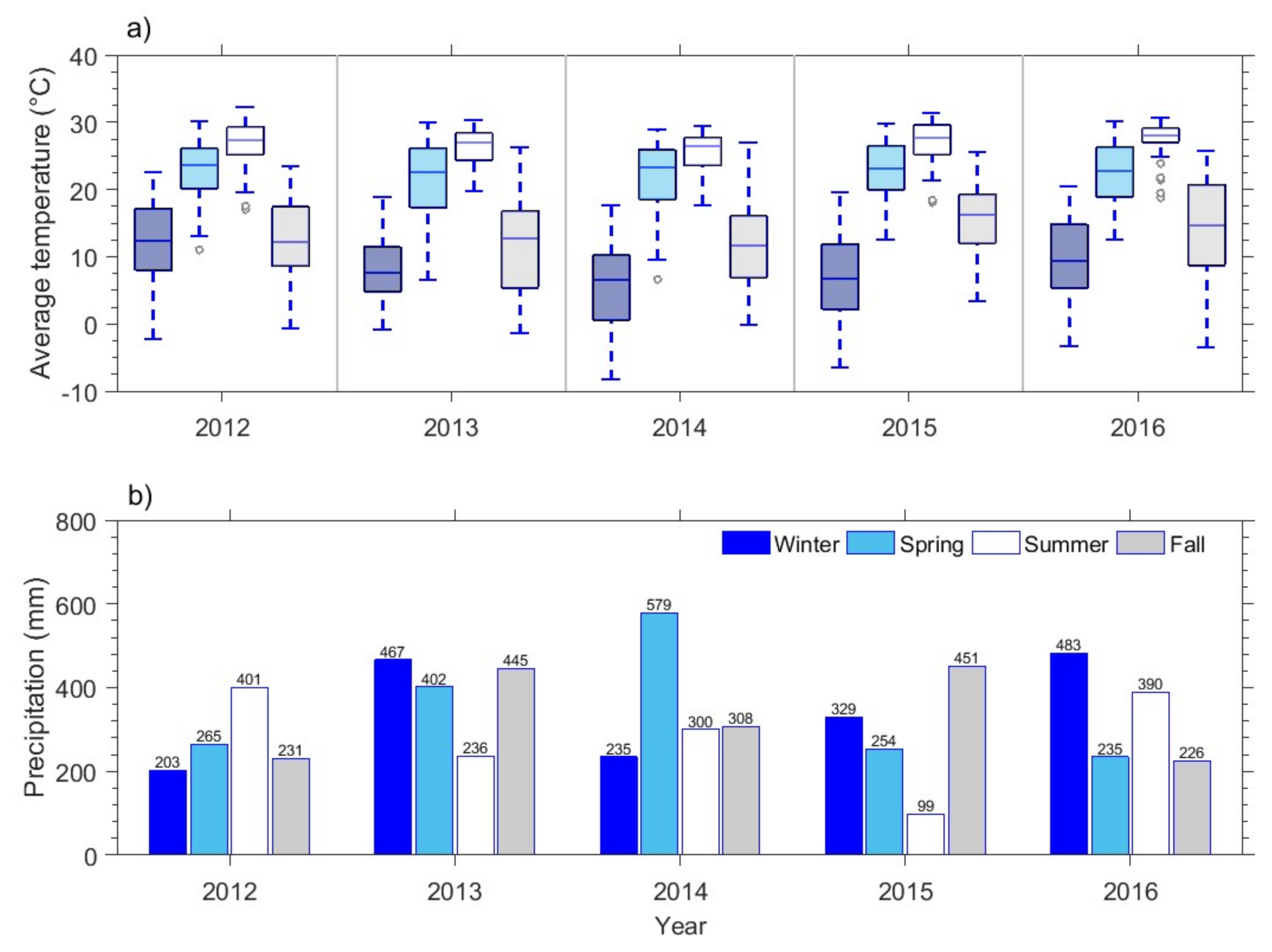

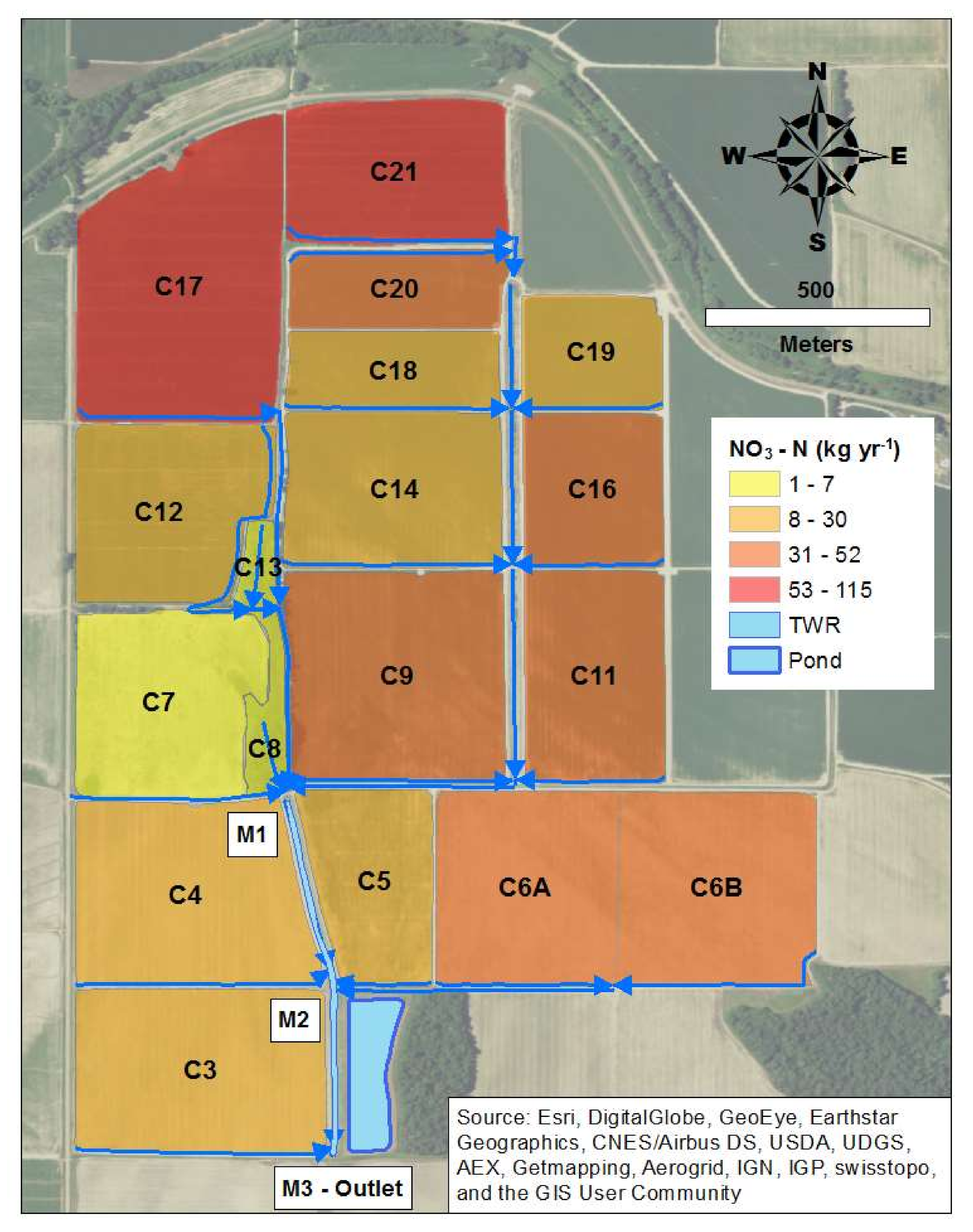
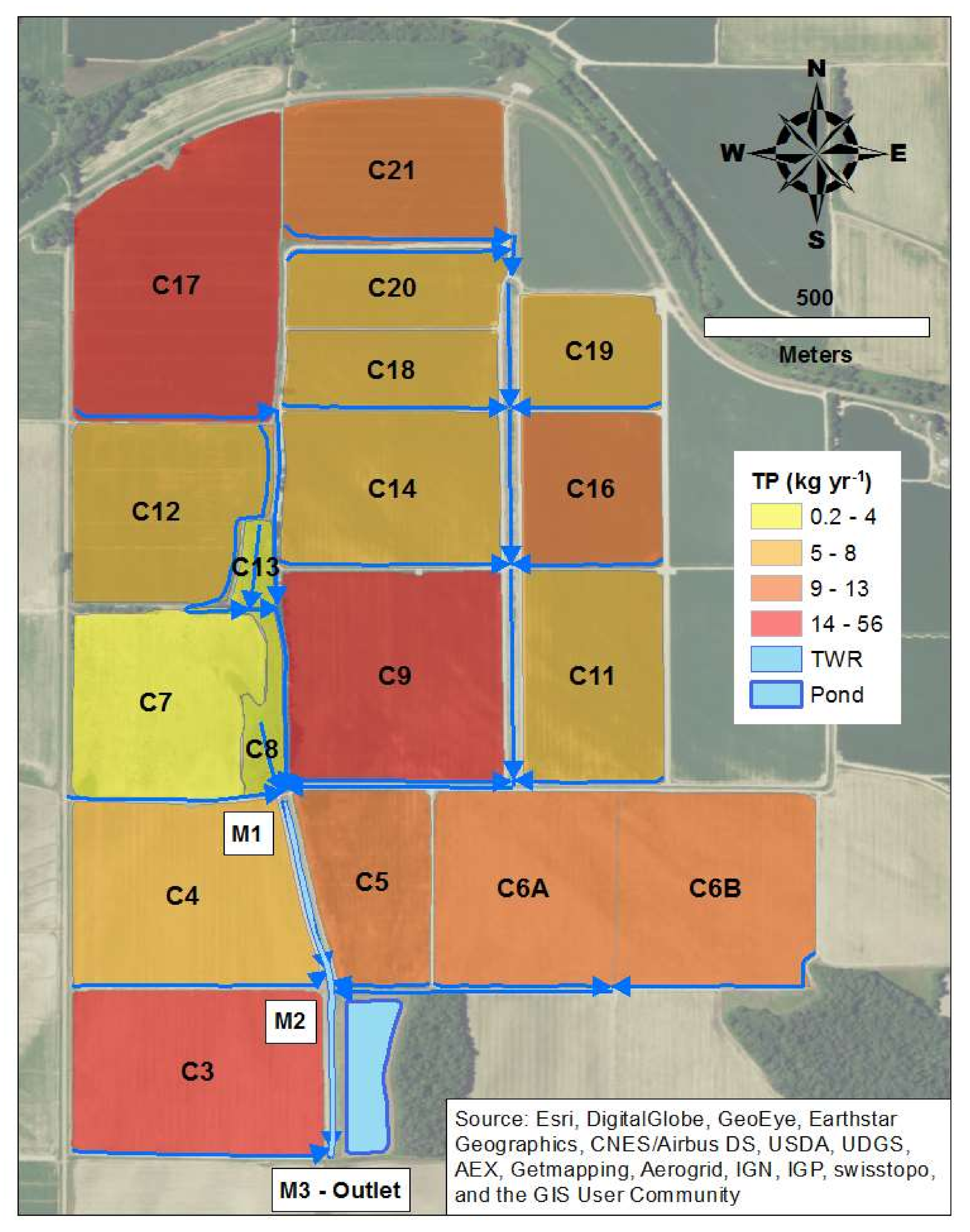
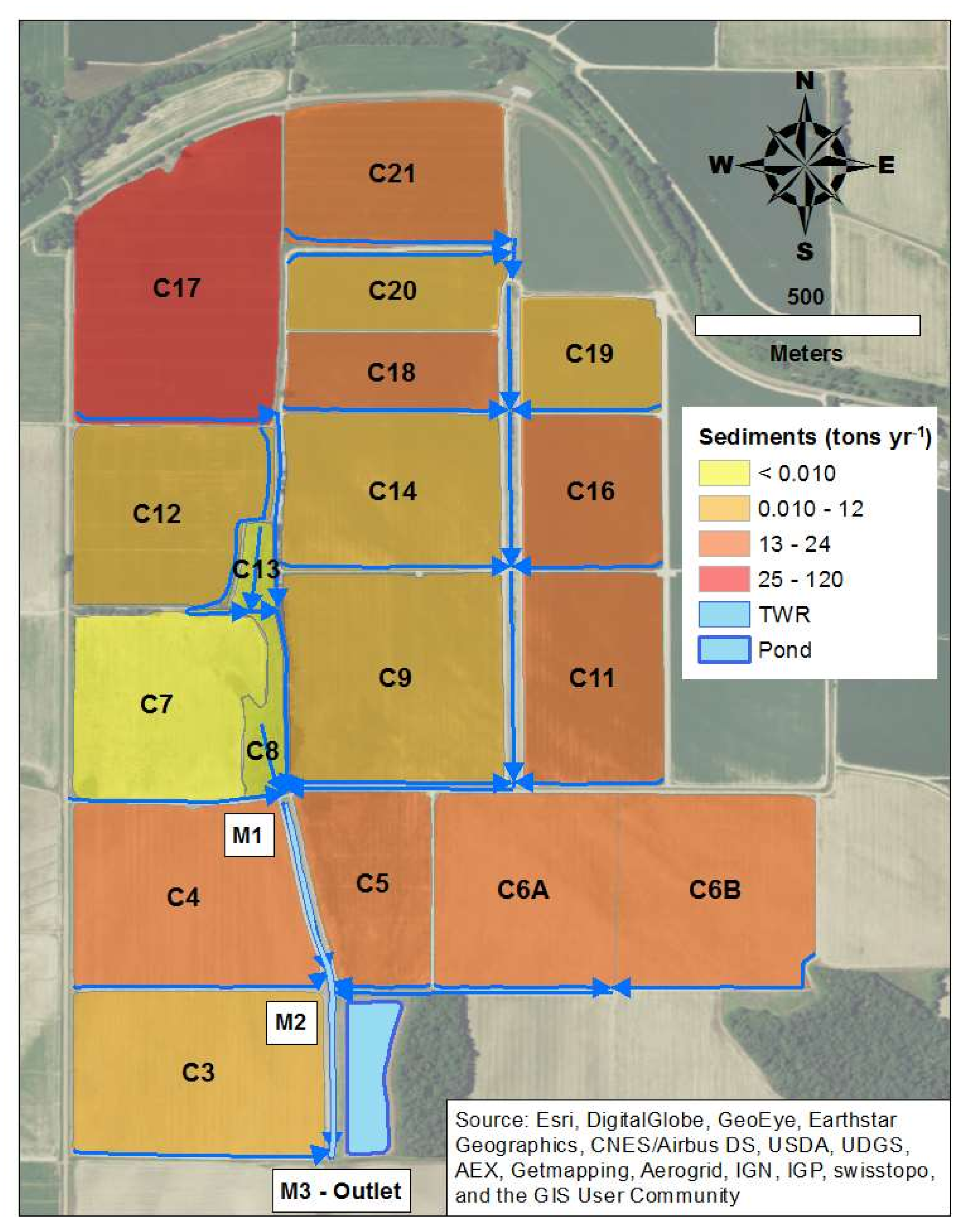
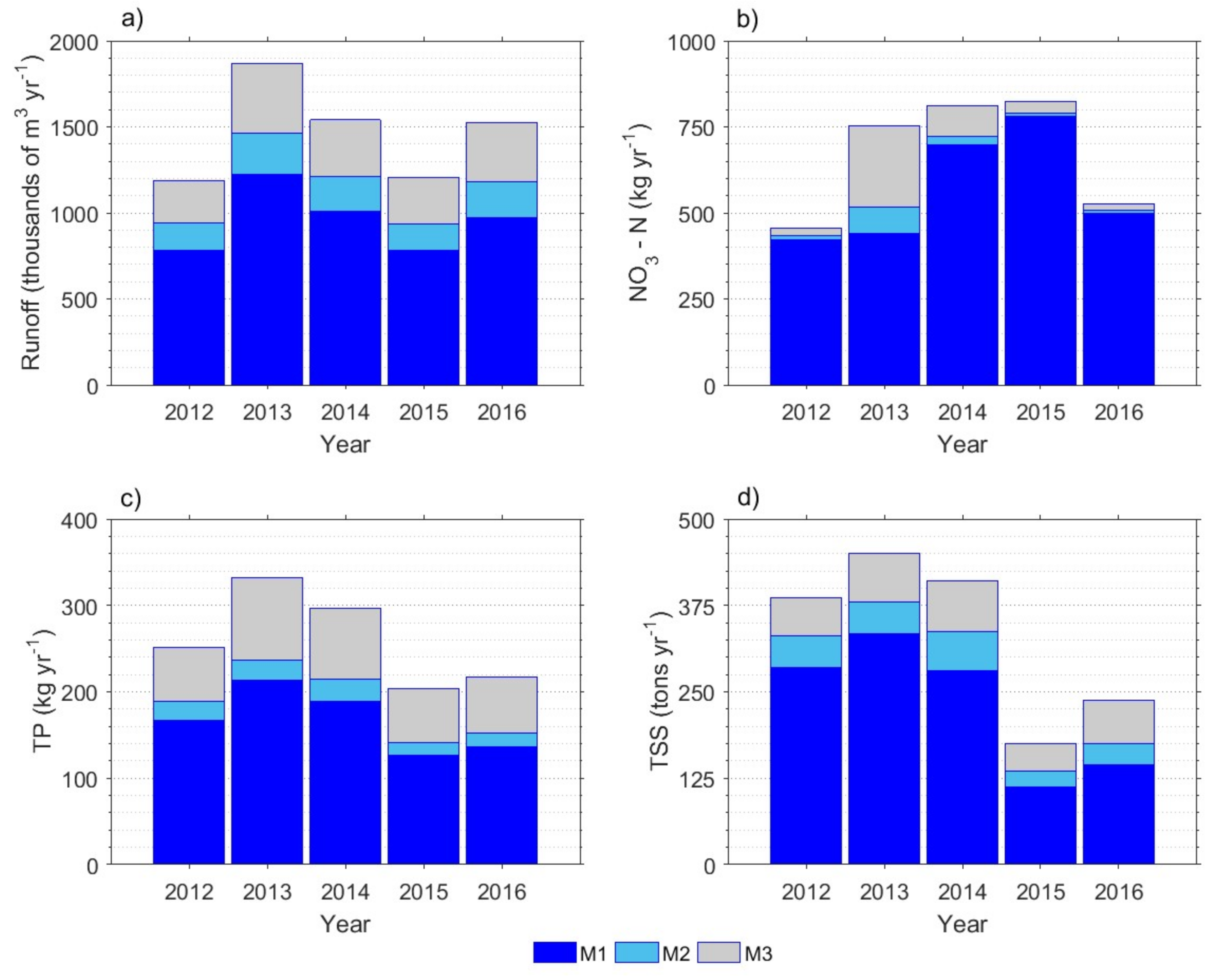
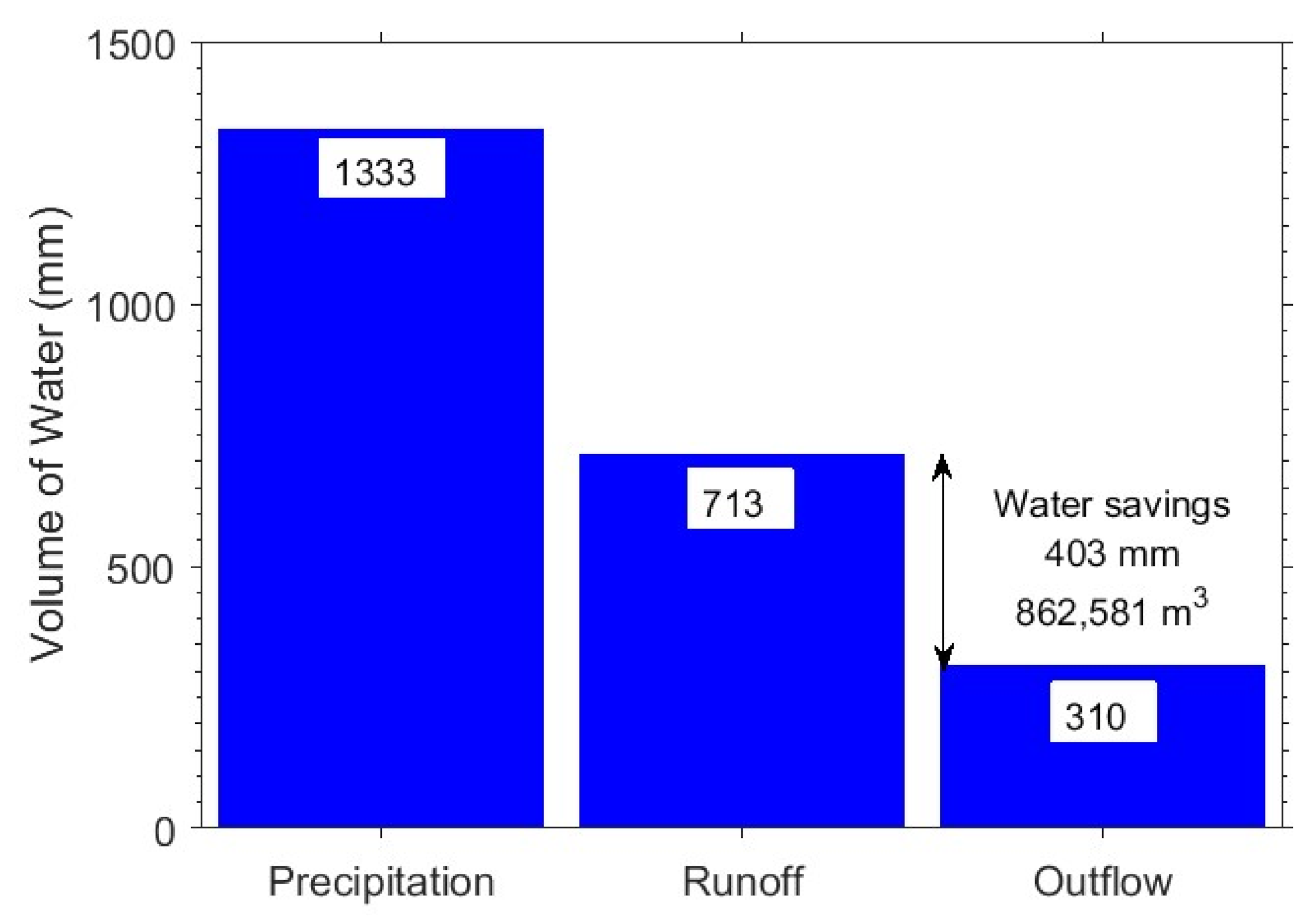
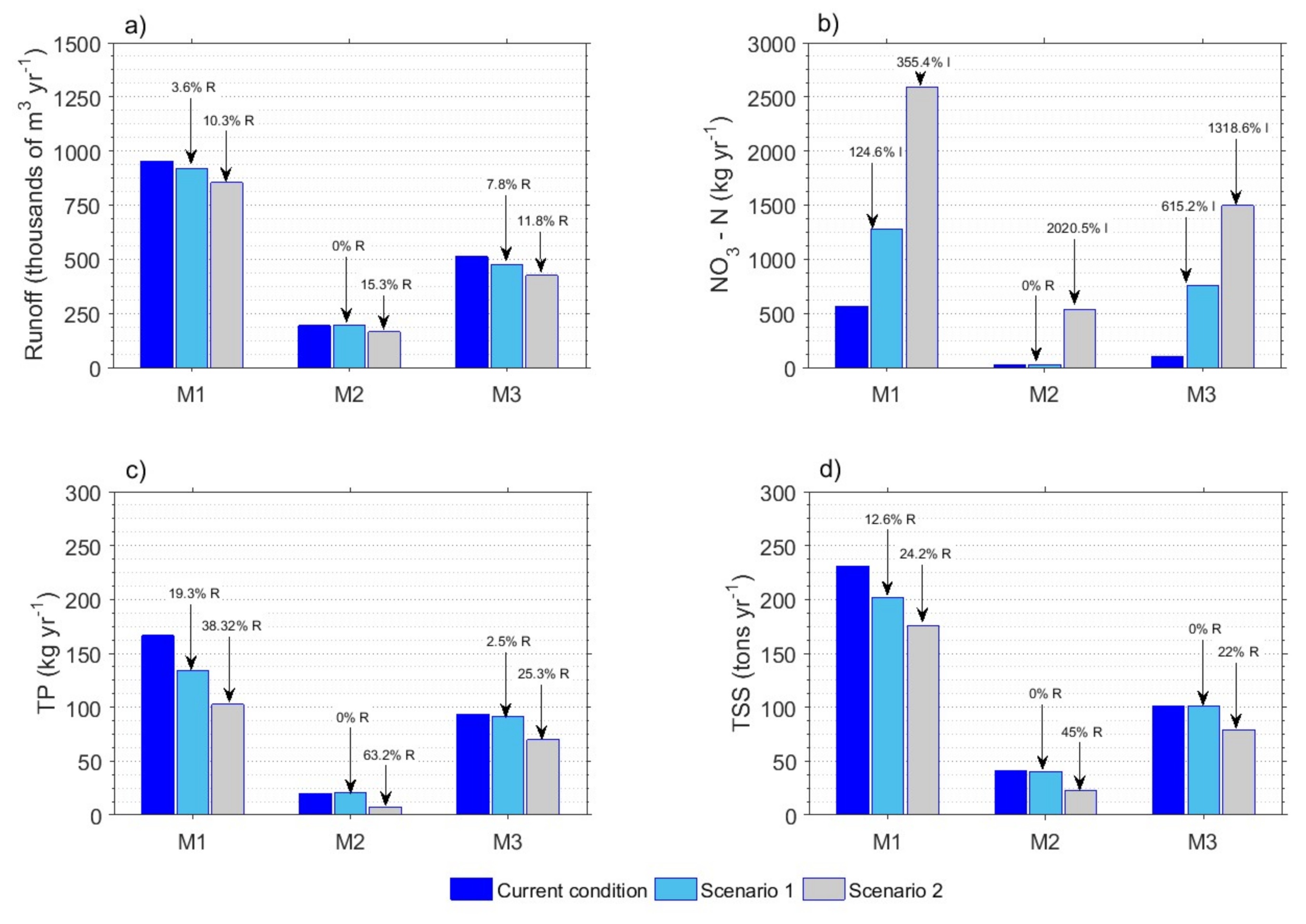
| Subwatershed ID | Area (ha) | Average Elevation (ft) | Average Land Slope | Soil Type | Hydrologic Soil Group | Land Use | ||||
|---|---|---|---|---|---|---|---|---|---|---|
| 2012 | 2013 | 2014 | 2015 | 2016 | ||||||
| C3 | 16.85 | 130 | 0.0012 | Db—Dowling silty clay loam | D | TRNAR | TRNAR | TRNAR | TRNAR | TRNAR |
| C4 | 17.00 | 131 | 0.0010 | Fm—Forestdale silty clay loam | D | Soybean May 11 | Soybean March 21 | Soybean May 11 | Soybean May 4 | Soybean May 9 |
| C5 | 9.40 | 131 | 0.0011 | Am—Dundee silt loam | C | Soybean May 10 | Corn March 21 | Soybean May 11 | Soybean May 4 | Soybean May 9 |
| C6A | 14.67 | 131 | 0.0018 | Am—Dundee silt loam | C | Soybean May 10 | Corn March 21 | Soybean May 11 | Soybean May 4 | Soybean May 9 |
| C6B | 15.74 | 131 | 0.0018 | Fb—Forestdale silt loam | D | Soybean May 10 | Corn Mar 21 | Soybean May 11 | Soybean May 4 | Soybean May 9 |
| C7 | 13.63 | 134 | 0.0020 | Fm—Forestdale silty clay loam | D | Pasture | Pasture | Pasture | Pasture | Pasture |
| C8 | 2.34 | 132 | 0.0006 | Db—Dowling clay | D | Forest | Forest | Forest | Forest | Forest |
| C9 | 18.70 | 132 | 0.0008 | Db—Dowling clay | D | Soybean June 12 | Rice May 26 | Soybean June 20 | Rice May 3 | Corn April 25 |
| C11 | 12.22 | 132 | 0.0017 | Fb—Forestdale silt loam | D | Soybean April 24 | Soybean June 10 WW October 25 | Soybean May 20 | Soybean April 9 | Corn April 25 |
| C12 | 13.41 | 133 | 0.0004 | Fb—Forestdale silt loam | D | Rice April 13 | Corn April 18 | Soybean May 8 | Soybean April 30 | Rice March 30 |
| C13 | 1.16 | 133 | 0.0016 | Fb—Forestdale silt loam | D | Forest | Forest | Forest | Forest | Forest |
| C14 | 13.89 | 133 | 0.0005 | Fb—Forestdale silt loam | D | Soybean April 23 | Soybean May 27 | Soybean May 6 | Soybean April 28 | Corn April 25 |
| C16 | 8.89 | 134 | 0.0012 | Dk—Silty clay | D | Soybean April 24 | Soybean June 10 WW October 25 | Soybean May 20 | Soybean April 9 | Corn April 25 |
| C17 | 22.54 | 135 | 0.0019 | Pa—Pearson silt loam | C | Rice April 13 | Corn April 18 | Soybean May 6 WW October 25 | Soybean June 12 | Rice March 30 |
| C18 | 6.95 | 134 | 0.0011 | Fb—Forestdale silt loam | D | Soybean April 24 | Soybean May 18 WW October 25 | Soybean May 6 | Soybean April 30 | Corn April 25 |
| C19 | 6.66 | 135 | 0.0012 | Dk—Silty clay | D | Soybean April 24 | Soybean June 10 | Soybean May 20 | Soybean April 9 | Corn April 25 |
| C20 | 7.00 | 134 | 0.0004 | Dk—Silty clay | D | Soybean April 24 | Soybean May 18 WW October 25 | Soybean May 7 | Soybean April 30 | Corn April 25 |
| C21 | 12.99 | 134 | 0.0013 | Dk—Silty clay | D | Soybean June 4 | Corn April 18 | Soybean May 18 WW October 25 | Soybean June 12 | Rice March 30 |
| Cropland | Activity | Application Rate |
|---|---|---|
| Soybean | Bedder | - |
| Plant | - | |
| Harvest | - | |
| Disk | - | |
| Corn | Bedder | - |
| Sprayer (pre) | - | |
| Plant | - | |
| Fertilizer | 150 kg ha−1 (soluble nitrogen) | |
| Fertilizer | 13 kg ha−1 (phosphorus) | |
| Sprayer (post) | - | |
| Sprayer (insecticide) | - | |
| Harvest | - | |
| Rice | Sprayer (pre) | - |
| Plant | - | |
| Harvest | - | |
| Disk | - | |
| Wheat | Plant | - |
| Fertilizer | 120 kg ha−1 (soluble nitrogen) | |
| Harvest | - | |
| Burn stubble | - |
| Cropland | Land Cover Class | Hydrologic Soil Type | ||
|---|---|---|---|---|
| C | D | |||
| Soybean | Plant | Soybean straight row (poor) | 88 | 91 |
| Harvest | Fallow + crop residue (poor) | 90 | 93 | |
| Corn | Plant | Rowcrop with residue | 85 | 89 |
| Rice | Plant | Rowcrop with residue | 85 | 89 |
| Wheat | Plant | Small grain straight row + crop residue (poor) | 83 | 86 |
| Category | Unit | TWR Channel Reach | ||
|---|---|---|---|---|
| M1 | M1–M2 | M2–M3 | ||
| Contributing fields | C7, C8, C9, C11, C12, C13, C14, C16, C17, C18, C19, C20, C21 | C4, C5 | C3, C6A, C6B | |
| Area | ha | 140.38 | 26.40 | 47.26 |
| Runoff | m3 ha−1 yr−1 | 6785 | 7364 | 6743 |
| NO3–N | kg ha−1 yr−1 | 4.05 | 0.96 | 1.7 |
| TP | kg ha−1 yr−1 | 1.19 | 0.77 | 1.56 |
| Sediment | ton ha−1 yr−1 | 1.65 | 1.54 | 1.28 |
| Subwatershed | Rank | ||||
|---|---|---|---|---|---|
| Runoff Production | NO3–N Load | TP Load | Sediment Load | Total | |
| C17 | 1 | 1 | 3 | 1 | 6 |
| C6B | 4 | 6 | 7 | 2 | 19 |
| C21 | 9 | 2 | 5 | 5 | 21 |
| C6A | 8 | 5 | 4 | 6 | 23 |
| C9 | 2 | 8 | 1 | 13 | 24 |
| C11 | 10 | 3 | 10 | 4 | 27 |
| C3 | 5 | 12 | 2 | 10 | 29 |
Publisher’s Note: MDPI stays neutral with regard to jurisdictional claims in published maps and institutional affiliations. |
© 2020 by the authors. Licensee MDPI, Basel, Switzerland. This article is an open access article distributed under the terms and conditions of the Creative Commons Attribution (CC BY) license (http://creativecommons.org/licenses/by/4.0/).
Share and Cite
Pérez-Gutiérrez, J.D.; Paz, J.O.; Tagert, M.L.M.; Yasarer, L.M.W.; Bingner, R.L. Using AnnAGNPS to Simulate Runoff, Nutrient, and Sediment Loads in an Agricultural Catchment with an On-Farm Water Storage System. Climate 2020, 8, 133. https://doi.org/10.3390/cli8110133
Pérez-Gutiérrez JD, Paz JO, Tagert MLM, Yasarer LMW, Bingner RL. Using AnnAGNPS to Simulate Runoff, Nutrient, and Sediment Loads in an Agricultural Catchment with an On-Farm Water Storage System. Climate. 2020; 8(11):133. https://doi.org/10.3390/cli8110133
Chicago/Turabian StylePérez-Gutiérrez, Juan D., Joel O. Paz, Mary Love M. Tagert, Lindsey M. W. Yasarer, and Ronald L. Bingner. 2020. "Using AnnAGNPS to Simulate Runoff, Nutrient, and Sediment Loads in an Agricultural Catchment with an On-Farm Water Storage System" Climate 8, no. 11: 133. https://doi.org/10.3390/cli8110133
APA StylePérez-Gutiérrez, J. D., Paz, J. O., Tagert, M. L. M., Yasarer, L. M. W., & Bingner, R. L. (2020). Using AnnAGNPS to Simulate Runoff, Nutrient, and Sediment Loads in an Agricultural Catchment with an On-Farm Water Storage System. Climate, 8(11), 133. https://doi.org/10.3390/cli8110133





